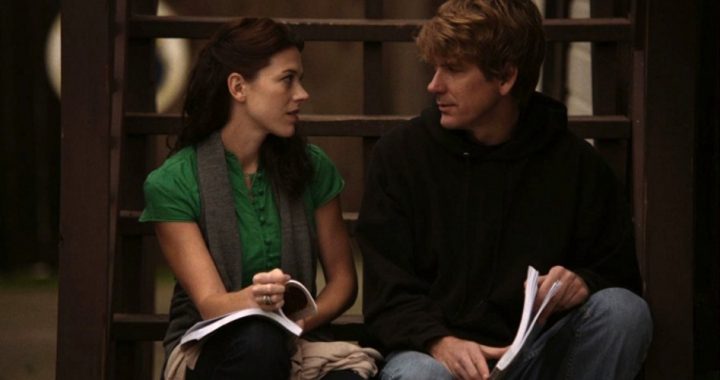
For this Valentine’s Day weekend, moviegoers looking for a date-night movie with their significant other have a choice between two extremes. On one end of the spectrum is Fifty Shades of Grey, a film based on the perverse novel by the same title. On the other end of the spectrum is Old Fashioned, an indie film that portrays a budding romance between two unlikely lovers and does so with a focus on honor and fidelity.
One of these films has received such ubiquitous coverage that you can’t help but be aware of it unless you have lived in near total seclusion for the last several months. The other is a very well kept secret, having scarcely been covered by mainstream media at all.
They are both controversial films, but for very different reasons. Fifty Shades of Grey earned its controversial status by portraying sexual perversion as entertainment and lending itself to the sexual objectification of women. Old Fashioned is controversial because it stands in such stark contrast to that objectification, instead affirming the value of women as human persons with real minds, emotions, and needs. It is a sad commentary that such values are now considered controversial. I have not seen Fifty Shades of Grey — nor will I — but I found Old Fashioned to be an enjoyable, thoughtful, sweet film that was worth seeing.
While Old Fashioned was not written or produced to compete with the degenerate Fifty Shades of Grey, the release date for the film is no accident. Rik Swartzwelder — who wrote, directed, and starred in the indie film — deliberately postponed the release to coincide with the release of Fifty Shades of Grey so that moviegoers would have a choice on Valentine’s Day weekend.
Set in a small college town in Ohio, Old Fashioned opens with free-spirited Amber driving until she runs out of gas in search of a fresh start. She rents an apartment above an antique shop owned by Clay, a quirky former frat boy with a reputation for being the local stick-in-the-mud. The two make an unlikely pair. He is disciplined and rule-driven; she colors outside the lines. They both have a past. She deals with hers by running away; he has built a wall around himself to keep himself safe. He is a Christian who is so rigid he no longer attends church because of the hypocrites; she is “spiritual,” but not a believer. Despite his counterculture rules regarding almost everything including dating, a romance buds and the result is that they both do some real soul searching, finding each other and themselves in the process.
Old Fashioned is a welcome departure from many faith-based films in some important ways. For one thing, I was struck right from the beginning by the production quality. While it is certainly not on par with large-budget films put out by the major studios, it is at the top of its game for indie films. Most of the acting is good with both Rik Swartzwelder (Clay) and Elizabeth Ann Roberts (Amber) carrying their roles quite well. Some of the supporting actors were a little stilted in their performances, but it didn’t really detract from the overall quality of the movie. The character development was well done. As the film progresses, quirks that initially left me wondering made more sense. It is good to see a faith-based film that doesn’t come off like a made-for-TV after-school movie.
It also avoids the pitfall of being preachy that Christian films too often run into. Clay, the Christian in the story, is flawed and blind to many of his flaws while self absorbed in others. Adult beverages are shown being consumed in both responsible and irresponsible ways, without too much fuss being made of it. The Bible is discussed and quoted several times in the movie, and it is done in a way that seems like a normal part of the characters’ lives and not something contrived for the sake of making a religious film.
The story is interesting and keeps pace quite well for the most part, although I felt as though it rushed through a couple of sequences and dragged a little in others. At one point, I actually looked at my phone to see what time it was; but all in all, I bought into the film and enjoyed seeing the story unfold.
Due to the sensitive nature of the issues addressed, this it is not a film for children. Frank discussions of sexuality, while not graphic, are spread throughout the story. As Clay’s past comes to light, it is revealed that he helped produce a sexually graphic DVD series while in college. He still has two friends from those younger, wilder days. While at a bachelor party for one of them, a stripper comes in and is about to begin her routine when Clay, not the person he once was, stops the show. As the story develops, it is revealed that Amber is divorced, and this is not really treated like a very big deal. All of these elements expose the difficulty associated with any modern movie attempting to reach back to “old fashioned” values. The result is that while Old Fashioned is indeed old fashioned compared to Fifty Shades of Grey, it would look a lot less so compared to Key Largo.
Old Fashioned does do a great job of sitting in direct contrast to films that sexually objectify women. In one scene Clay asks an old college buddy, who is still living the wild life, “When did treating women with respect become the joke?” Even when the movie shows Clay failing to be perfect in the way he lives that out, at least he is seen trying and failing, instead of failing to try. This movie tries and succeeds.
Photo of Rik Swartzwelder (as Clay) and Elizabeth Ann Roberts (Amber) in Old Fashioned




